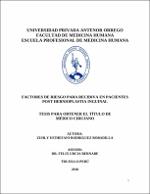Factores de riesgo para recidiva en pacientes post hernioplastia inguinal

Ver/
Descargar
(application/pdf: 386.1Kb)
(application/pdf: 386.1Kb)
Fecha
2018Autor(es)
Rodriguez Bobadilla, Zuhly Esthefani
Metadatos
Mostrar el registro completo del ítemResumen
Objetivo: Nos preguntamos determinar los factores de riesgo para la recidiva en
pacientes post hernioplastía inguinal.
Material y Métodos: Se realizó un estudio comparativo, de casos y controles, de
corte retrospectivo. Se estudiaron 156 pacientes, 48 casos que presentaron recidiva
y 107 controles sin recidiva, que tuvieron hernioplastía inguinal en Clínica San
Gabriel Lima en el periodo 2017. Se realizó un análisis univariado, bivariado y
multivariado de los factores asociados.
Resultados: Las variables con nivel de significancia aceptado fueron antecedente
de hipertensión (OR 0.383 IC 95% 0.179-0.819; p=0.012), antecedente de
tabaquismo (OR 21.805 IC 95% 8.348-56,954 ; p=0.000), antecedente de
herniorrafía (OR 3.603 IC 95% 1,450-8,955; p=0.004), complicación
postquirúrgica dolor inguinal crónico (OR 2.335 IC 95% 1,166-4.674; p=0.016 .El
análisis multivariado indicó que tabaquismo obtuvo(p=0,001; OR 35.98 IC 95%
11,82 -109.57) antecedente de herniorrafía (p=0.001; OR 8,99 IC 95% 2.64 -
30.67) y edad (p=0,020; OR1,04 IC95% 1.01-1.08) con significancia para factores
de riesgo para recidiva de hernia inguinal postoperatoria.
Conclusiones: El tabaquismo y la herniorrafia son más probables de encontrar en
pacientes con recidiva de hernia inguinal postoperatoria, frente a aquellos pacientes
que no presentan estos factores de riesgo. Objective: To determine the risk factors for recurrence in patients after inguinal
hernioplasty at Clínica San Gabriel.
Material and Methods: A comparative study of cases and controls, retrospective. 156
patients, 48 cases and 107 controls were enrolled, whose information was randomly
extracted from the clinical records of the institution. A univariate, bivariate and multivariate
analysis of the associated factors was performed.
Results: The variables with accepted level of significance were antecedents of
hypertension(OR 0.383 IC 95% 0.179-0.819; p=0.012), antecedent of smoking(OR 21.805
IC 95% 8.348-56,954 ; p=0.000) , antecedent of herniorrafia(OR 3.603 IC 95% 1,450-
8,955; p=0.004), , postsurgical complications (OR 2.335 IC 95% 1,166-4.674; p=0.016,
The multivariate analysis indicated that smoking obtained (p=0,001; OR 35.98 IC 95%
11,82 -109.57) and antecedent of herniorrafia (p=0.001; OR 8,99 IC 95% 2.64 -30.67).
Conclusions: Smoking and history of herniorrafia are more likely to be found in patients
with postoperative inguinal hernia recurrence, compared to patients who do not present
these risk factors.
Palabras clave
Colecciones
- Medicina Humana [2969]

